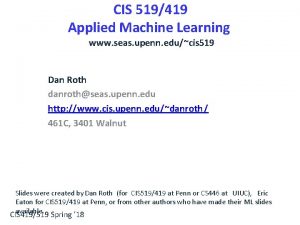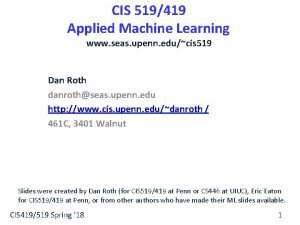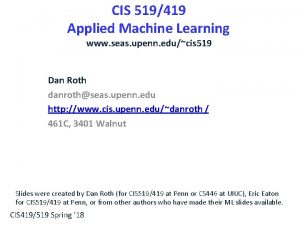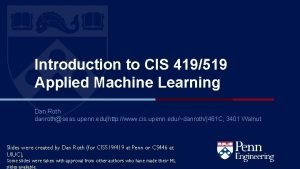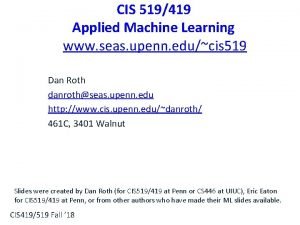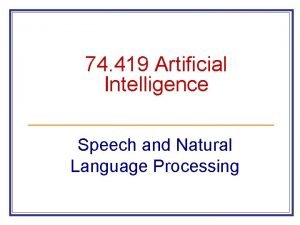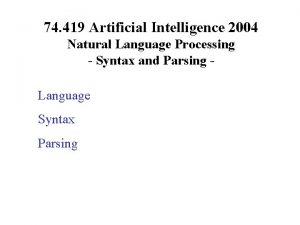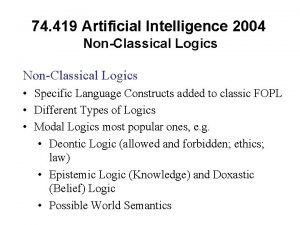74 419 Artificial Intelligence 2004 Speech Natural Language


















- Slides: 18

74. 419 Artificial Intelligence 2004 Speech & Natural Language Processing • Speech Recognition • acoustic signal as input • conversion into written words • Natural Language Processing • written text as input • sentences (well-formed or not) • Spoken Language Understanding • analysis of spoken language (transcribed speech)

Speech & Natural Language Processing Areas in Speech Recognition • Signal Processing • Phonetics • Word Recognition Areas in Natural Language Processing • • • Morphology Grammar & Parsing (syntactic analysis) Semantics Pragamatics Discourse / Dialogue Spoken Language Understanding

Speech Production & Reception Sound and Hearing • change in air pressure sound wave • reception through inner ear membrane / microphone • break-up into frequency components: receptors in cochlea / mathematical frequency analysis (e. g. Fast-Fourier Transform FFT) → Frequency Spectrum • perception/recognition of phonemes and subsequently words (e. g. Neural Networks, Hidden-Markov Models)



Speech Recognition Acoustic / sound wave Filtering, Sampling Spectral Analysis; FFT Frequency Spectrum Signal Processing / Analysis Features (Phonemes; Context) Phoneme Recognition: HMM, Neural Networks Phonemes Grammar or Statistics Phoneme Sequences / Words Word Sequence / Sentence Grammar or Statistics for likely word sequences

Speech Signal Analog-Digital Conversion of acoustic signal → Sampling in Time Frames = “windows” Characteristics of a Speech Signal Ø formants - strong frequency components; characterize e. g. vowels, gender of speaker; dark stripe in spectrum Ø pitch – fundamental frequency (baseline for higher frequency harmonics like formants) Ø place of articulation (recognition model based on model of vocal tract) Ø change in frequency distribution


Video of glottis and speech signal in ling. WAVES (from http: //www. lingcom. de)


Speech Signal Analog-Digital Conversion of Acoustic Signals → Sampling Analysis of Signal in Time Frames (“windows”) Characteristics of a Speech Signal Ø formants - strong frequency components; characterize e. g. vowels, gender of speaker; dark stripe in spectrum Ø pitch – fundamental frequency (baseline for higher frequency harmonics like formants) Ø place of articulation (recognition model based on model of vocal tract) Ø change in frequency distribution





Speech Recognition Characteristics Speech Recognition vs. Speaker Identification Speaker-dependent vs. speaker independent Single word vs. continuous speech Large vs. small vocabulary


Additional References Hong, X. & A. Acero & H. Hon: Spoken Language Processing. A Guide to Theory, Algorithms, and System Development. Prentice. Hall, NJ, 2001.
 Upenn cis 519
Upenn cis 519 Cis 519 upenn
Cis 519 upenn Cis 519
Cis 519 Cis 419
Cis 419 Cis 419 upenn
Cis 419 upenn Mycin advantages and disadvantages
Mycin advantages and disadvantages State space search
State space search Searching for solutions in artificial intelligence
Searching for solutions in artificial intelligence 15-780 graduate artificial intelligence
15-780 graduate artificial intelligence Knowledge manipulation in ai
Knowledge manipulation in ai Structural knowledge in ai
Structural knowledge in ai American association for artificial intelligence 17 mar
American association for artificial intelligence 17 mar Kecerdasan kepemimpinan
Kecerdasan kepemimpinan Uas kecerdasan buatan
Uas kecerdasan buatan Math and artificial intelligence
Math and artificial intelligence Peas example in ai
Peas example in ai 15-780 graduate artificial intelligence
15-780 graduate artificial intelligence Machine learning xkcd
Machine learning xkcd Fuzzy proposition
Fuzzy proposition
